I finally concluded that my pad is dying and will be replaced, so I’m laboriously typing this on my phone. I cannot imagine what Joe will say. He took the mick out of my irritation when using the pad saying “it’s like going downhill, mountain biking in a wheelchair then complaining about a bumpy road.” I quite liked my pad and will get a replacement ASAP. The discussion about how long a post should be is now redundant. It will be governed by my index finger skills on this phone and I make no claims to typing as fast as teenagers can on their smartphones.
This might well turn into a ramble but I will start, as promised, with Carob, Alfarroba in Portuguese. It’s a small tree, sometimes with ancient gnarled trunks, which almost everyone who ever had a Mediterranean holiday has seen. You might even have shaded yourself beneath one without knowing it’s name. I did exactly that on Crete in 1981, sadly too late as I was already the colour of a boiled lobster.
We have one, very small Carob tree on our land which grew back after the 2003 fire. This is the time to gather the dark brown-black seedpods. Portugal is the largest producer of Carob worldwide but we usually see the pods dropping onto the roads where the traffic grinds them to dust. The hard seeds are not the edible part, it’s the pod with its distinctive caramel-like flavour, often likened to chocolate, which is used. We buy Carob “flour” and use it in bread making, while the Portuguese also flavour desserts, cakes and a liquor with it. This year I wanted to photograph the waste on the roads and there was nothing to see. I presumed the Romany population have gathered everything up for themselves or their animals as we have seen them collecting the pods in past years. Our neighbour Monique sometimes gives some to her goats. It’s naturally sweet and can be up to 60% sugar, so she limits their intake, not for dental reasons but for health. It’s not exactly a healthy addition to their diet but of course, if you google it, because it’s a “natural” sugar there are plenty of articles telling you that it’s healthy. I always thought the market for Carob products was quite small but several years ago quite a large area near Silves was newly planted with it. It seems that it’s being looked at for the production of biofuels. I love that terminology. Let’s convert that 60% sugar content to alcohol and call it biofuel. 😀😀
On the branches, alongside the pods are the relatively insignificant flowers.
The bees like them and in a couple of months we might be able to buy enough Alfarroba honey to last coral a month or two. I never tasted a better honey with it’s deep brown colour and deliciously distinctive flavour. We introduced Coral to it and she’s able to get through quite a few jars in a short time. Coral loves it so much that she contacted the producer and tried to get him to export to the UK but he refused in spite of her offering to pay more than double the going rate here.
Carob is a native Mediterranean tree, adapted to the dry summers, though I have read that some irrigation will improve the yield. Sadly, across the Algarve, huge plantations of Avocado trees are going in and seem to be expanding exponentially. “Green gold” is a term being used. They apparently have shallow root systems, absorb most of their water from the top 15cms of soil, and require an awful lot of summer irrigation yet a recent news article stated that that their water requirements are similar to other fruit trees. No doubt the borehole pumps will lower the water table and commercial gain will override the environment and local ecology again.
I also mentioned Opiliones, which, for the zoologically inclined is the scientific name for Daddy Longlegs or Harvestmen. I know that some people refer to Craneflies as Daddy Longlegs, but for me it’s always been those funny “spiders” with the little round bodies. They’re not true spiders, though they belong to the Arachnids, and they look as though their head, thorax and abdomen have all been joined together into one round body. A bit like a “potato man” or “Humpty Dumpty.” Well, this is the time of year that they seem to aggregate into clusters! I never saw it in the UK but when we were looking for a property to buy in Portugal in 2002 we were repelled at one doorway when we were faced with an enormous cluster of probably hundreds of thousands of Harvestmen, covering the upper half of the door, looking like a huge beard which started pulsating as we disturbed it. We’ve never seen such a big cluster since then but I photographed this small aggregation under the eaves of a roof and you can’t even see the bodies, just a mass of hairlike legs. No one seems to know why they aggregate but it must surely have something to do with mating. Nature is weird!
Talking of weird. Check out this egg.
As the hens get to the end of their laying life, they seem to be depleted of calcium and often lay very thin shelled eggs which always surprise me by cracking so easily into a pan and often around the pan because of the surprise. It looks as though the hen ran out of shell to complete this egg and the floppy bit at the top is just a membranous extension of the very thin shell. We give lots of calcium supplements, so if it’s not calcium depletion it must just be that her innards forgot to do the job.
We have been pushing our ageing bodies quite hard for the past week. Autumn seemed to arrive with a couple of days threatening thunderstorms and I drove through torrential rain which turned the road into a stream just 4 km away, but nothing at Passil. The daytime temperatures are still in the upper 20’s so when we spent time clearing some bamboo one day, then three days on our steep hillside pulling Cistus and Gorse up by their roots before banging in about 60 rebar posts for extending our electric fence, we certainly sweated. Not quite as bad as the heat at Vedanta’s though. I was “on a mission” the first day and only left the last bit of clearing when it got too dark to see. But it’s done! Including a gate on the track to our neighbours house. Poor Obi is terrified of the fence after experiencing a few shocks and won’t even go within 2 metres of it, let alone jump it. We went up the hillside leaving him barking on the other side of the fence and when Frank eventually went back down. Obi was in a right state of anxiety, shaking and hyper salivating. I hate using human terms for animals but he undoubtedly has “separation anxiety.”
With early autumn various seeds are starting to fall. Our Agapanthus flowered incredibly well this summer and I just counted about 80 flower heads with the seedpods splitting to reveal the dark black, lightweight winged seeds. Photo sideways!!!!
The seeds are very similar to those of thd NZ Flax. I’m keeping my eye on one plant which grew from seed here but has unusually compact flower heads with darker flowers. I’m determined to collect seeds from that specimen to see whether they grow true. Could be a new variety and get a name. I’ve also been collecting Eucomis seeds (remember the pineapple flowers?) I’ll always remember that they need some winter chilling before they’ll germinate.
The shadier land is still decorated with the beautiful Amaryllis flowers, though they’ve done their dash in front of the house and their seeds are starting to swell. Why did the site turn this photo sideways?
Interestingly, their seeds will look very similar to the Scadoxus seeds, and they also send out a single shoot which produces a tiny bulb before sending up the first leaf. They’re closely related to the Crinums (remember the photo of Crinum asiaticum) and even produce the hybrid “Amarcrinum.” Our C.asiaticum flowers produced just two seeds after my efforts at hand pollination. Each one is about 3cm in diameter and the first time I saw one, I thought it was a seedpods, containing seeds, and I mistakenly started cutting into it before realising that it was a single huge seed.
Our tomatoes are still carrying heavily but coming to an end, and our raspberries are still giving us a bowl for breakfast every day with some canes promising an autumnal continuation. The black figs are finished but I have another 30 green figs to dry. I just made an experimental fig loaf. I used the liquid from a jar of dried black figs in caramelised syrup ( amazing with ice-cream) and one finely chopped very ripe green fig. It’s crazy how a little addition to the recipe totally changes the outcome. In spite of it’s strange shape it’s a deliciously moist sweet bread.
I have no idea how much I’ve written, but it’s time to stop and join Frank to snack on the fresh loaf.
PS I discovered that when I reduce the photo size they rotate. Only the pics at full size stay the right way. Bloody technology 😀😀










That fig loaf looks good! Well done for making the effort to blog on your phone. Look forward to your ‘ramblings’. It’s getting pretty cold in Edinburgh in the evenings now. X